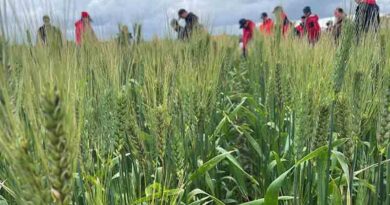Australia: Cropping market – December update
16 December 2021, Australia: The Elders Weather rainfall outlook suggests, multiple cold fronts with the potential to bring widespread rain over southern and eastern Australia beginning 22 to 26 December, but the strongest fronts will commence 5 to 9 January and 10 to 14 January 2022.
In the West the strongest cold fronts are expected between 28 December 28 to 1 January and 10 to 14 January 2022.
From the field
South Australia
“Yield has been average to above average for the lower Mid-North region, lentils have ranged from 1.5 to 2.8t/ha, canola 1.8 to 3t/ha and wheat 2.5 to 5t/ha.
“Aside from harvest, summer weed control is well underway with the main weed spectrum including cut leaf mignette, fleabane, skeleton weed, melons, thistles, potato weed, wireweed, and odd weeds like statice and jersey cud weed.
“In terms of planning for next season, farmers are well aware of global supply chain challenges for fertilizer and chemical, with most willing to commit to orders early to mitigate price and availability risk in 2022.” – Lyndon May, Elders Technical Services Manager, South Australia.
Victoria and Riverina
“Harvest is close to concluding in the Mallee after a late season. Yields around Swan Hill were below average, however strong prices made for a successful harvest overall.
“Wet conditions in the Riverina and central New South Wales have impacted canola yields, knocking around 0.5 to 1t/ha off original yield estimates. While it’s disappointing to lose tonnage, thankfully prices have maintained a high level and, in some cases, farmers have been able to graze canola stubble adding another income source. The full extent of damage to wheat and barley remains to be seen, the expectation is that a large amount of grain will be downgraded to feed.
“In Western Victoria harvest is only just getting underway after a very wet winter period and a cool spring. If the region can avoid heavy rain, yield and quality are expected to be high but there is a long way to go.
“Farmers are already looking ahead to next season, purchasing and storing fertilizer and chemical on farm to mitigate supply and price risk.” – Craig Farlow, Elders Technical Services Manager, Victoria and Riverina.
Growers have pricing power
Nathan Cattle from Clear Grain Exchange shares his thoughts on the current grain market in Australia.
The reality is Australian growers have likely never had this much pricing power in global grain markets before. Yet prices bid to growers have never been this far discounted when compared to global values. That’s the market scenario we find ourselves in currently.
The world needs Australian grain because they can’t get it readily from elsewhere in the world due to production issues over the past year. This is not likely to change until the northern hemisphere crops become available, which for the majority, is the middle of next year.
This means Australian grain is setting the global price.
Yet as numerous analysts have commented on over recent months, current prices bid to growers are well below international values on an equivalent basis.
Further this discrepancy in price is quite possibly as high as it has ever been. The price growers are receiving for their grain has likely never been cheaper versus global values.
Are growers selling too quickly?
There has been plenty of commentary about supply chain access, funding constraints by buyers, the changing quality profile of the Aussie crop due to wet weather, as contributing factors towards disconnecting the price bid to growers from the international market.
The simple fact that growers have been willing sellers at the prices bid to them, is the largest reason creating cheap grower bids when compared to global values.
It’s the buyers right to act commercially, like any business, otherwise they don’t survive long term. This means if their advertised bids keep getting filled with grain sales, the bids are not likely to improve.
There is no way that the amount of grain to be shipped out of Australia over the coming marketing year has been bought by the trade yet, regardless of which buyers have shipping slots for bulk export.
Similarly, domestic users, container traders, and other opportunistic traders are unlikely to have accumulated their requirements.
I can understand the mentality to sell. Historically strong prices and strong yields will result in healthy profits this year for many. But are growers maximising this year’s returns? The fact is grower bids are well below global values.

Market indicators
















